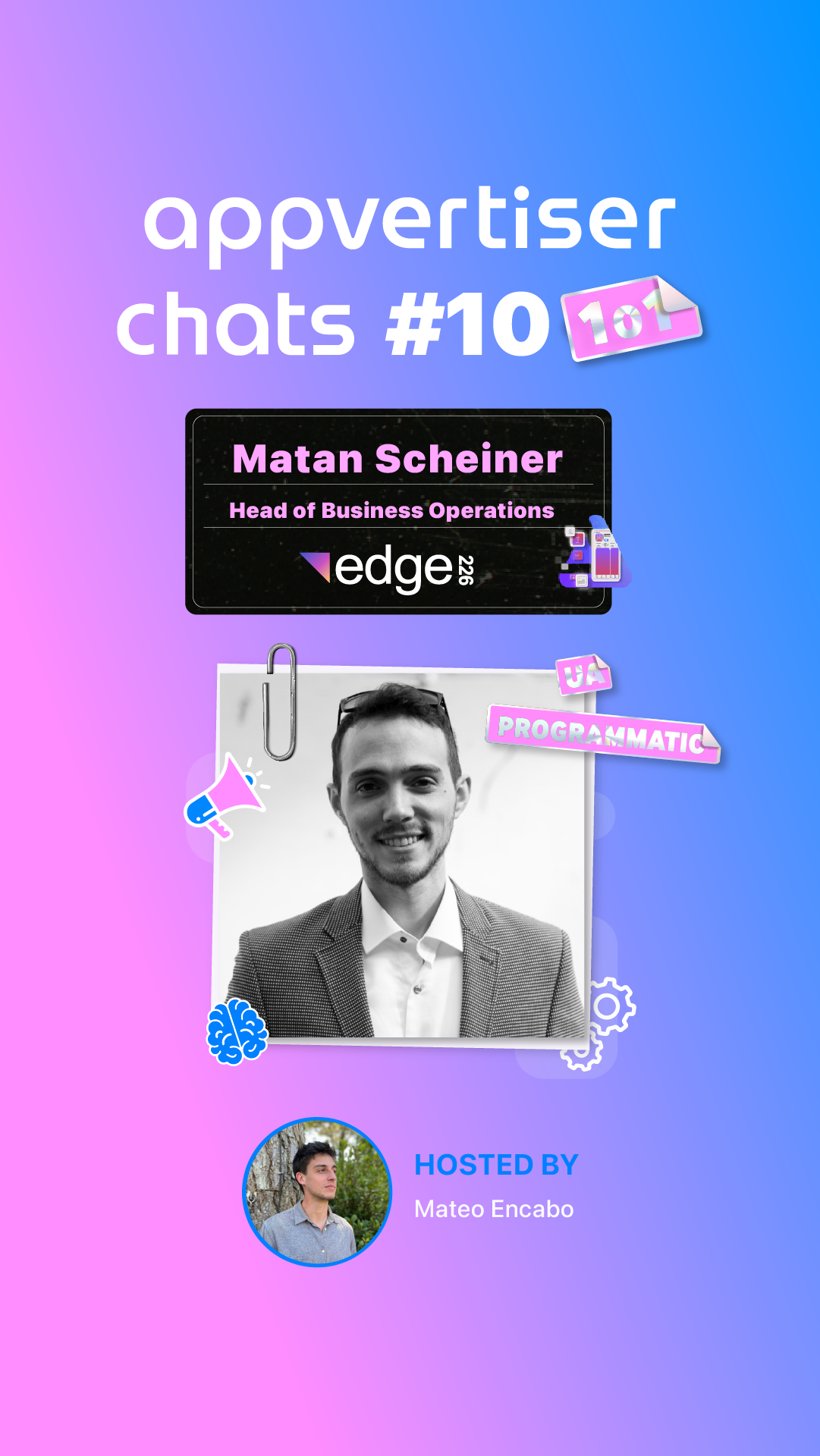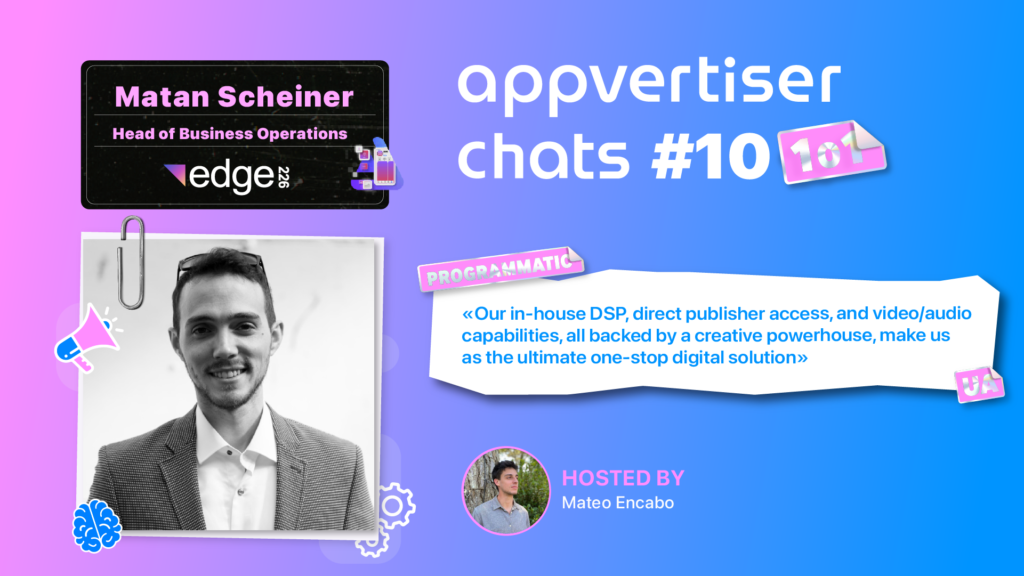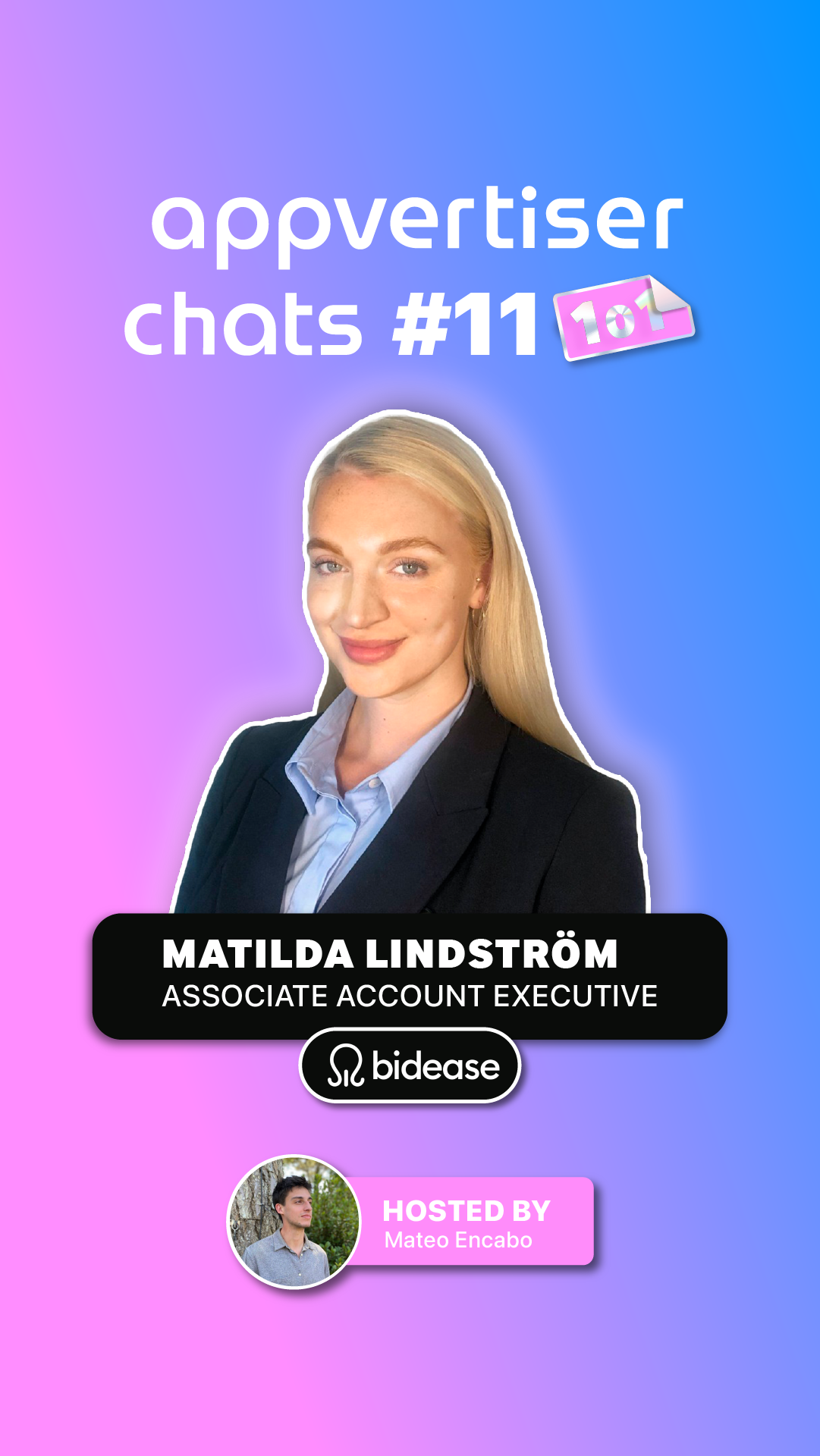
Edge 226’s Performance Solutions with Matan Scheiner | Appvertiser Chat #10

Welcome back to Appvertiser Chats, your go-to series for the hottest app-marketing discussions. Here, industry experts deep dive into their products, share their insights on the industry, and predictions for the future of IT.
From how to keep their client’s metrics real, the best performance-boosting ad formats and to their experience nailing a trust-worthy buying algorithm, for this edition Edge226’s Head of Business Operations, Matan Scheiner, shares us his further forward thinking about the industry 🤺📈
Curious enough? Jump in now!
Tired of reading?
🎙 Spotify: https://podcasters.spotify.com/appvertiser/episodes/Edge-226s-Performance-Solutions-with-Matan-Scheiner–Appvertiser-Chat-10-e2f9k0i
▶ Youtube: https://youtu.be/5g0drEQ1b6w
Q: I’m very happy to be with you today, Matan. Please go ahead and introduce yourself!
A: First of all, thank you for having me. It’s a great pleasure to be here. As you surely know, I’m the Head of Business Operations at Edge226. Basically, I’ve been within the company for a bit more than five years now.
I used to be more on the customer success side and then shifted up to head of business operations, which is like a tailored position to be the contact point between different departments – the clients, the media buyers, the product, data analysis, etcetera-. It’s just to make sure that everything is aligned within the integrations, assure everything works smoothly. And of course, to make sure that we know the desires of the clients and that we know what will be the steps to meet them.
Previously, I used to work in WebPulse Mobile, like a mobile department of WebPulse group. Later, Edge226 acquired this department, I think in 2019. I was part of this group.
Q: There’s one thing we would like to do before we jump into the more technical stuff… I’d like to know: what’s your personal favorite app? And what’s the category you enjoy the most working with?
A: I think that my favorite niche is something related to grocery delivery or food delivery. First of all, because I’m a user, man. I would try to cook, but I think it would be better for me and my wife that we’re going to order out a takeout. Not necessarily, of course, food. It can be groceries, and then I can try to make some curries and stuff 🍲.
But I think this is some kind of a vertical that everybody uses. Not everybody is going to play hyper casual games or financial applications, but everybody does need food.
And I really enjoyed the time working with all those vendors. It was like a blooming vertical during 2020, 2021, I mean during COVID-19. So nobody went outside, everybody just tried to order food. I think the combination of our capabilities and the needs of the clients, and of course the needs of the end user, this combination had a magnificent timing that actually benefit each other. We drove the traffic, they benefit from the user, the user got the food. So it was like a nice ecosystem that I took part of and I really enjoyed it.
I was always impressed by these food delivery companies, especially apps, because of their marketing campaigns: they were nonstop ads in your face on every YouTube video, on the street, on every kind of placement. So you made the first time purchase, and then, they got you hooked.
Q: I’m curious about the name, so I need to ask you. Where does Edge 226 come from?
A: I used to joke that the domain of Edge was taken and then we had to find some numbers.
But the real answer is that in general, I think that Edge cannot stand alone as a name of a company. And one of the co-founders participated in some Ironman triathlons, and he’s really into it and really into sports. So, he figured out that we can add those numbers 2-2-6, which is the combination of the kilometers that you need to swim, a bicycle, and if I’m not mistaken, to run. 🏃♂️
So this is the combination. And, if you would like to think about it, there’s some kind of a philosophy, a view of that. It can say that at the beginning, even something that is looking like really challenging and out of reach, if you show determination and with time, it seems like you can reach this.
I think that this is what we do here in Edge226. If we confront some challenges or something, it looks crazy. And with this industry, every second day something changed. But our team is really into it. And eventually, we meet the point.
Q: It’s interesting. I think you should exploit that idea even more. Like I saw you, for example, one of your solutions is peak.
A: Maybe that’s a bit related. Yeah, everything is somehow related to going to edge peak… We also have like a platform called Echo. Maybe if somebody’s shouting within the mountains, I don’t know, but everything is actually combining to the same place.
Q: What is Edge226? Why is it a great opportunity to tap into it and what gives you a differential value from other similar companies?
A: Edge226 is performance marketing agency. I think the best title would be like a one-stop shop. We have our own in-house DSP that we developed on our side. We have the direct publishers. We can support, the DSP traffic if needed. We also have video capabilities. We also have player for audio capabilities. We have a creative design team in-house.
So we can, first of all, adjust, resize, or create videos, banners, entities, whatever you need for your needs. And I think the most unique part is that we can combine like an overview about the ecosystem and we can touch every single point of the industry and support the clients, whatever his desires and needs. I think it’s one benefit working with us.
Of course, if you would like me to be more detailed about like what are the benefits of working with us, I think, first of all, the algorithm: this is like a game changer with the mechanism of our DSP buying.
And I will elaborate about it in a second. I think that another thing is that we are very proud with the sense that we are fully transparent, which means that not only our account managers explain everything to the clients and be very clear about the messages and how we can reach the goals. You actually have full visibility of the buying.
Each client have its own seat and then they can access it and see what we buy, where we buy it, when we buy it. Is it self-serve? It can be self-serve, but most of our clients are actually doing manage. Our media buying team are doing all optimizations and the media buying utilization.
Q: Now I want to jump on some particular questions that I think you guys are super experts to answer. The Holiday Season already passed by… How does Edge226 prevent errors when the algorithm is working normally in a time that is unconventional?
A: I think that the answer would be that the combination of what I just mentioned before, the human being that are touching the system with the algorithm itself. So even if you see spikes during holiday seasons or winter time works differently than summertime, you need to adjust the buying. So there is one person – at least – that is watching each one of those campaigns and making sure that we are still aligning in terms of the KPIs, the volumes, the needs of the clients.
We can avoid any abnormal activities in terms of spikes or seeing a reduced buying in some cases. And also, as part of this industry, we’re pretty much working 24-7. So every time that is like a need from our clients or need from the system, somebody at Edge226 is in place to make sure that we are aligned.
Q: Do you have some kind of alerts that indicate special events or something moving out of the expected?
A: Yeah. We do have internal alerts that will identify if we see a spike with the impression buying, or if you see like the CTR is different. We even have an alert that will indicate if a specific campaign did not buy impressions or clicks for the past 60 minutes, for example. So it’s really detailed about what we’re doing every single hour.
Q: And switching gears, I see you guys have one feature called ‘programmatic bid decisioning’. This would be about doing real-time bidding and deciding how much to bid, right? How does this work?
A: In general, the algorithm behind the DSP started a long time ago and is constantly improving and being developed by our algorithm team and developers.
Let’s take an example that you have billions of opportunities to publish an ad in terms of like placements or applications, etc. The algorithm is in a split second, needs to understand what will be the best decisions that it would need to take in order to be more accurate for the actual segmented paying targeted users that the client is looking for.
From the opportunities, it needs to figure out what will be the relevant bids that it needs to take. And of course, from this portion, we’re going to win some portion of the win rate, and these are the impressions that we actually buy with the best location that the algorithm managed to find or understand.
Of course, from that, comes to users. Now it works on two ways. One of them is like, the historical information that we have. It’s a combination of an audience look alike that used to work before, and maybe it’s relevant to this specific vertical geo, you name it. And then it makes this decision in a split second.
Q: In our previous edition we’ve been discussing how hard it is to prevent fraud. Do you have any tools for this, especially in programmatic when you’re executing actions that are automated buys?
A: I think that when I started out this – you can say working in this industry- fraud was like something that nobody knows how to prevent it. And from time to time, you saw like a new tool coming. Everything is involved with different locations of the fraud, click spamming or IPs, etcetera.
Initially we implemented many solutions to our buying in order to make sure that we mitigate those abnormal activities on the spot and not sending those conversions or even clicks and impressions to the clients. Moreover, I can say that besides, as you mentioned, all the automatic stuff that is going in the background, our media buyer team is extremely investigating every piece of information that we have to make sure – for example, the time from click to install looks decent, that the CTR looks decent-. So nothing is abnormal. And we try to make sure that every piece of information that we send to our clients is clean.
If I was an advertiser, I would use it. We see less than 1% with each and every one of our clients, even if crazy scale, it’s below 1%. So that’s a good thing that I’m very happy with.
Q: Huge number! Are you seeing Edge226 having a particular success with any of the categories from the app store, in categories in particular? And if so, why do you think it is?
A: First of all, it’s very dynamic. So if you see something that is working well today, not necessarily it’s going to be great tomorrow. But I think that the best part is that you touch every aspect and every vertical that is currently available. For example, if you ran airline applications during COVID, that probably didn’t work well. But food delivery, as I mentioned before, works amazing.
And I think that nowadays we see great trends with games. I can let you know why, because I’m going to emphasize a bit about the differences between, for example, peak and social buying.
Social buying tend to drive very cheap installs, for example, not necessarily going to focus on the deeper funnel of the events. So you want to get like a bulk of installs, which can use the application for a few days and then leave the application. Our algorithm is more focused for the post install events and the deeper funnel.
So we tend to optimize during the initial days for more installations, because our algorithm is like a machine or a monster that always needs to be fed. Once it gets enough information, it can pivot its buying based on what segments works best, creative size, creative type, bundle, placement, sub publisher, SSP, etc. We tend to see very nice trends in retention rates and return on ad spend in terms of LTV of the clients, because if I’m going to reach a client that is paying for the application.
This is for the gaming, but you can say the same thing about the first food delivery. As you mentioned before, once somebody’s down on the application, most likely you have a loyal user that is going to order more and more food.
We are optimizing towards the deeper funnel to make sure that the client not only gets the quantity – we focus more on the quality. So maybe the CPIs via our DSP programmatic buying will be a bit higher than social, but eventually the CPAs and the ROAS and the retention will be significantly better than other channel.
Q: You just mentioned trends. Are you seeing any kind of trends in the ad creative side? What test plan would you recommend for a company that is just starting?
A: Yeah. Obviously bigger sizes are the better, not only for user acquisition, for the branding side, because somebody actually sees what you publish. It’s not only like a blurry green banner, it’s something that we can actually benefit from or even see like a promo code or whatever that I can use as a user. Also, of course, videos work best. They tend to be more expensive than banners or interstitials, but the quality of those users are much higher.
And we do tend to test from time to time different methods of creatives, such as autostalking, task overlay, etcetera, just to make sure that we reach the actual users that would like to download the application and will take action following that.
Q: You guys have a creative production studio as well. So tell me, do you handle the creation of the ads?
A: If the client wants us to make it, yes, we sure can. Our design team can make everything from scratch. Even if it’s videos, statics, audio ads. But in general, recently I saw many clients that are giving us whether they have and just asking us if we can bigger sizes, smaller sizes, or try to shift the characters there. But it really depends on the client.
Q: We always ask this question: how do you see 2024 for mobile apps? Especially with upcoming privacy restrictions. Any new challenges, trends, opportunities?
A: It seems that 2024 started pretty well in terms of different new applications that are popping up at the store each and every second day. I’m yet to be able to say which version seems to work better nowadays. It seems like it’s a combination of games and financial applications.
And about the challenges that we’re going to see, as you mentioned, it seem to be privacy issues. Companies need to make sure that they can support SKAD 4.0 and luckily, this is something that we are able to do on our side.
The clients tend to work with device matching or probabilistic matching via iOS. But from time to time, you see that this percentage is decreasing, and they would like to support the privacy of the users, making sure that it’s like a black box via SKAD. So you need to make sure that you can support app installs and possible events that are coming via SKAD.
That’s one… And the second trend that I see on my side, and I think it’s going to bloom very quickly, is CTVs. This is like a very nice trend that we’re seeing. And again, luckily, we see very nice results and scale on our side. And more and more clients would like to shift from only user acquisition via mobile to OTT, and of course, connected TV – because let’s be frank, a lot of people are using smart TVs, and they would like to gain the benefits of every aspect of it.
Q: And now, are you guys already creating a ChatGPT plugin?
A: Everybody’s doing that! I guess so. To be frank, it’s not something that is related to me directly, but I think I heard in the corridor some discussions about whatever AI is… Every two seconds, there is a new solution or a new plugin.
Q: That would be it! Thank you so much, Matan. Chatting with you was great. And great to know your products, Edge226 name, history, and great to know you as well.
A: Thank you, guys.



